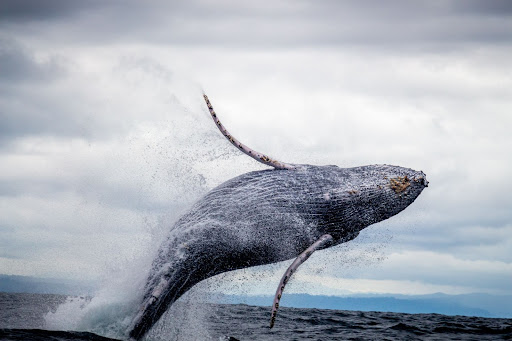Whale watching in Hawaii provides a unique opportunity to witness the beauty of these Magnificent Creatures in their natural habitat. And with this state’s coastal scenery as the backdrop, you can observe their graceful movements, listen to their captivating songs, and appreciate their impressive size and strength all at once. But to make the most of your whale-watching experience, it’s important to be aware of the optimal time for spotting these incredible beings in the surrounding waters.
Different Whale Species In Hawaii – Whale Watching
Before we talk about the best time to observe whales in Hawaii, it is essential to familiarize ourselves with the various species found in these waters.
In the waters of Hawaii, the humpback whale reigns as the most commonly spotted whale species during Whale-Watching Season. These magnificent creatures dominate the scene with their frequent appearances. However, it’s worth noting that encounters with other species such as pilot whales and false killer whales are also possible, but they only happen on rare occasions.
Fact: Hawaii is the only state in the US where humpback whales mate, calve, and nurture their calves.
When’s The Best Time For Whale Watching In Hawaii?
The most favorable time to watch whales in Hawaii is from December to March. This period corresponds to the peak season for humpback whales, ensuring a higher likelihood of sightings. Although humpback whales and other whales may be spotted as early as October or September and as late as May, humpback whales are observed the greatest between the months of December and March.
It’s also worth noting that there are a couple of websites that say the whale watching season starts in November, but in reality, it’s not. You might spot some but it is not the optimal month. Also, dedicated whale-watching tours are less common during that time.
To increase your chances of experiencing these magnificent creatures, plan your whale watching adventure in Hawaii between December and March when humpback whale sightings are at their highest.
Popular Whale-Watching Spots In Hawaii
Whale watching Hawaii tours are popular on various Hawaiian islands, including Maui, Kauai, Oahu, and the Big Island. These islands offer great spots to witness the breathtaking sight of whales in their natural habitat.
It’s worth noting that these tours are typically available only from December to March, which coincides with the peak whale watching months in Hawaii. In these months, the humpback whale population is at its highest, increasing the chances of encountering these majestic creatures.
It is worth noting that whether you opt for a whale watching tour from Maui, Kauai, Oahu, or the Big Island, it is necessary to plan your visit between December and March for the best opportunity to observe the impressive display of humpback whales in the waters surrounding Hawaii. Avoid believing in people that say you can watch them from November or in the late days of May, as the chances are very low during these months.
7 Responsible Whale Watching Tips
As you prepare to go whale watching on the Big Island or any of the other islands mentioned above, it’s essential to be mindful of responsible whale watching practices. By following all the necessary guidelines, you can ensure a memorable and ethical experience while respecting the well-being of these magnificent creatures.
Let’s explore some key tips for responsible whale watching that will enhance your encounter with these majestic beings:
Maintain A Respectful Distance
When observing humpback whales, it’s necessary to keep a safe and respectful distance from the whales to avoid disturbing their natural behaviors. We recommend you or anyone going on such tours stay at least 100 yards (90 meters) away from the whales. It’s for your own safety.
Use Binoculars
To enhance your whale watching experience without getting too close, you can rent out or bring your own binoculars or zoom lenses. This way, you can observe the whales up close while maintaining a safe distance.
Follow The Guidelines Of The Tour Operator
If you’re on a guided whale watching tour, listen to and follow the instructions of the knowledgeable guides. They are trained to ensure a responsible and respectful whale watching experience. If they tell you to stop doing something, stop right away. It’s for your and the whale’s safety.
Do Not Approach Or Chase The Whales
One thing you should always keep in mind is to avoid approaching the whales too closely or attempting to chase them. This can disrupt their natural behavior and cause stress to the animals.
Reduce Noise And Avoid Sudden Movements
As you’re observing the whales, try to keep noise levels to a minimum and avoid sudden movements. That’s because loud noises and disturbances can startle the whales and impact their behavior.
Do Not Feed Or Touch The Whales
As a tourist or someone who just wants to watch these mammals, it is crucial to never attempt to feed or touch the whales. These are wild animals; any interaction should be purely observational and non-intrusive.
Report Any Sightings Or Concerns
In case you witness any violations or have concerns about irresponsible whale watching practices, you should report them to the appropriate authorities or local whale watching organizations.
Final Thoughts – Whale Watching In Hawaii
To enhance your whale watching experience in Hawaii, it is recommended to join tours. These tours provide an opportunity to get up close to the whales while being guided through the entire experience. They can also guide you in knowing the best time to watch or observe these magnificent creatures in their natural habitat.
Enjoy your adventure and make lasting memories while whale watching in Hawaii!

